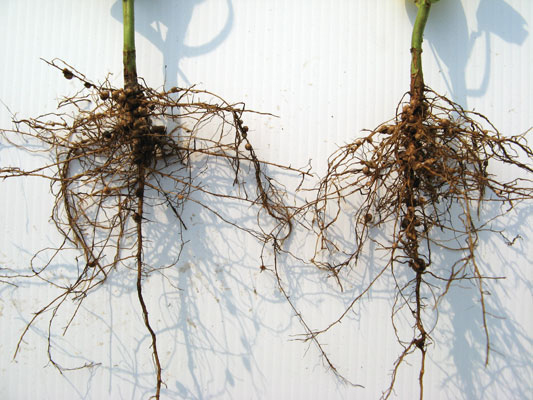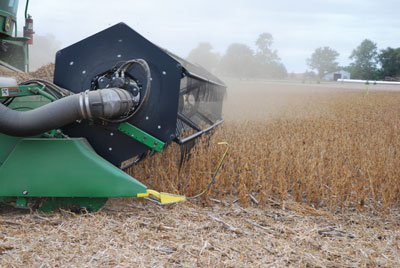
Features
Inoculants
Seed & Chemical
More reasons to consider soybean inoculants
Rising commodity prices during the last two years are helping to generate greater interest in soybean inoculants, which may have been a tougher sell in the past.
December 22, 2008 By Blair Andrews
Benefits usually outweigh costs.
Rising commodity prices during the last two years are helping to generate greater interest in soybean inoculants, which may have been a tougher sell in the past. Horst Bohner, soybean specialist with the Ontario Ministry of Agriculture, Food and Rural Affairs, says that after experiencing a few lean years, growers are now showing tremendous interest in all crop inputs. “We have struggled in a lot of ways to increase soybean yields significantly over the last number of years and, when prices are very low, producers have a hard time spending a lot of money on the crop,” says Bohner. “But now with higher prices, producers are keener to chase higher yields and profits.
 |
|
| The network of roots on soybean plants that were inoculated shows an obvious benefit, just in visual terms alone. Photo courtesy of Becker Underwood. Advertisement
|
”Soybean inoculants are touted as a relatively inexpensive way to boost soybean yields while delivering a solid return on investment. The inoculant’s role is to fix nitrogen with the plant. Soybeans fix nitrogen from the air with a bacterium, Bradyrhizobium japonicum, which is not indigenous to Ontario. In large numbers, the bacteria receive a protected growing environment, carbohydrates and minerals and, in turn, provide the plant with nitrogen. Bohner says a 50 bushel/acre crop of soybeans will remove 210 pounds/acre of nitrogen. Some of this N comes from residual nitrogen in the soil, but between 50 and 75 percent will come from nodules that form on the roots. Inoculation, therefore, is a must for fields that have never been planted to soybeans. Traditionally, inoculation is also recommended for sandy soils, soils with a pH level under 6, if the field has been flooded, and if soybeans have not been planted in a field in five years.
So, what about fields that have a more consistent pattern of growing soybeans? Bohner says innovations in the newer inoculation products, combined with the higher commodity prices, may be providing reasons to use inoculants on fields with a history of soybeans. “It is not widely accepted in Ontario that you can increase soybean yields in history fields. We’re starting to show from work that we’re doing that you can pick up one to two bushels and sometimes even more on history fields by using an inoculant every year.”
Recent technological innovations are geared toward increasing the yields and making the inoculants more convenient to use. Bohner says important improvements include higher concentrations of bacteria and the use of a pre-inoculant that prolongs the shelf-life of the product. “You don’t have to apply the inoculant within the same day of planting the seed, which is the old way,” says Bohner, noting that bacteria could dry out if applied a few days before planting. Pre-inoculants contain extenders that allow for a shelf life of 30 days or more.
For an inoculant company like Becker Underwood, the technological advances and the higher soybean prices, in particular, are bolstering the case for its products. “The story is the change in commodity prices that allows a significant return on investment,” says Ralph deVries, Becker Underwood’s district manager for Eastern Canada. DeVries uses Becker Underwood’s HiStick N/T inoculant to illustrate his point. This new category of inoculant, which is “BioStacked,” was first made available to Ontario farmers for the 2008 growing season. The inoculant comes in both liquid and sterile peat formulations. DEKALB and Pride Seeds also made the inoculant available on their varieties. HiStick N/T contains two biologicals to help improve the performance of the soybean plant. The first, Bradyrhizobium japonicum, colonizes the soybean root system to enhance nitrogen fixation. DeVries says this component provides a one to two bushel per acre improvement compared to non-inoculated fields. In addition to the rhizobia, the product contains a biological called Bacillus subtilis, which acts as a ‘nodulation trigger®’ that increases nodule mass. The result is an additional 1.5 to 1.8 bushels per acre over the first biological. Together, the two are said to produce an overall yield boost of 2.5 to 3.8 bu/ac. Given today’s higher commodity prices, deVries says the end result is a significant return on investment.
“With soybeans at $12.00 per bushel, and a 2.8 bushel per acre increase with the BioStacks (HiStick N/T), your return on investment is 540 percent,” explains deVries. “If you look at soybeans at $6.00/bu with a traditional, single component inoculant a couple of years ago, you’re looking at a return on investment of 97 percent.” According to Horst Bohner, it is these types of claims that make the research on inoculants on history fields in Ontario a worthwhile pursuit. In particular, he is looking for more Ontario data in terms of when and where inoculants will produce a response, and if those responses would be consistent.
 |
|
| The true measure of success for inoculants comes when it matters most, at harvest. |
In 2008, he had 12 replicated large-scale field trials to assess various inoculants such as HiStick N/T and Cell Tech SCI on history fields. “I don’t want to be out there saying, ‘We should all use an inoculant every year to make money.’ I don’t think that’s where we’re at,” says Bohner.Dr. Dave Hume, professor emeritus at the University of Guelph, has been conducting research trials on soybean inoculants for several years. Part of the research has compared HiStick N/T with the regular HiStick product. “When I averaged all the data together, we average 1.5 bushels per acre higher yield from the N/T versus just the HiStick,” says Dr. Hume, noting that the trials were conducted on new soybean soils.
As for an increase on fields where soybeans have been grown before, Hume doesn’t know for certain, but surmises that such a response is likely. “Everything that I have done would indicate that there would be an extra 1.5 bushels, but I’d like to have more data than I’ve got. I would speculate that they would be additive: you would get a response from the first inoculant and another from the HiStick N/T.”
Hume expects to have better data on history soils when the 2008 trials are completed. In the meantime, Becker Underwood is already responding to the rising popularity of its products. The company recently announced ambitious plans for its inoculant production plant in St. Joseph, Mo., to complement the Canadian production in Saskatoon, Sask. Set for completion by January 2009, the project will nearly triple the production capacity for inoculants for soybeans, peanuts and lentils. The announcement of the expansion noted that 2008 was a record year for the company’s biological products, with projections for greater demand in 2009.